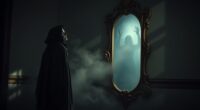Science can explain many ghost sightings through a mix of psychological, cultural, and physical factors. Cognitive biases, emotional states, and expectations shape how you interpret experiences. Environmental elements like infrasound and changes in electromagnetic fields can also create sensations that feel supernatural. Additionally, natural occurrences might mislead you into thinking there’s something paranormal happening. If you want to uncover more about how these influences affect ghost beliefs, keep exploring the fascinating details behind this phenomenon.
Key Takeaways
- Hallucinations from sleep paralysis or psychological disorders are often misinterpreted as ghostly encounters, providing a scientific explanation for many sightings.
- Changes in brain activity, particularly in the temporal lobe, can create sensations perceived as supernatural experiences.
- Environmental factors like infrasound and carbon monoxide poisoning can induce feelings of dread or hallucinations, explaining ghostly perceptions.
- Common noises, such as creaks, are usually caused by natural processes rather than paranormal activity, debunking many ghost claims.
- Misinterpretations of natural phenomena and the power of suggestion contribute significantly to the prevalence of ghost sightings.
Cultural Beliefs in Ghosts
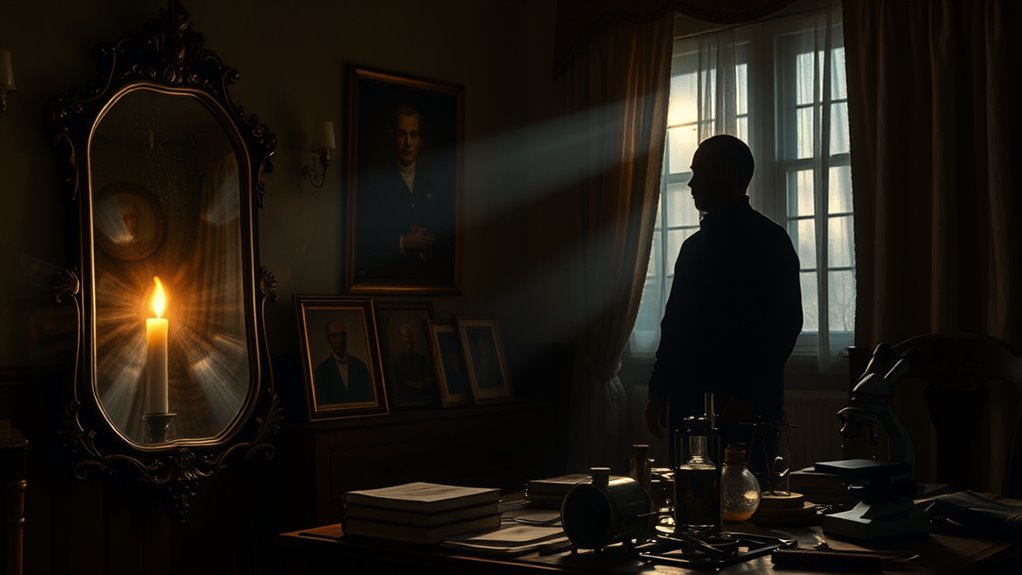
Cultural beliefs in ghosts have shaped societies in profound ways, as they often reflect our deepest fears and hopes about life and death. Ghost stories serve as powerful cultural metaphors, intertwining with existential questions about existence. For instance, the Mexican Day of the Dead honors deceased loved ones, believing their spirits return to celebrate. In various cultures, ghosts symbolize societal aspects, aesthetics, and afterlife beliefs, like Japan’s “yūrei” and China’s “hungry ghosts.” Interestingly, 36% of the U.S. population identifies as believers in ghosts, showcasing how these narratives not only preserve folklore but also influence your perceptions of life and death. As you engage with these stories, you find comfort, fear, and understanding—emphasizing the complex role ghosts play in shaping human experience and cultural identity. Additionally, the use of AI tools can enhance storytelling efforts by automating content creation and improving narrative structure. The way ghosts are perceived can vary greatly, often influenced by cultural factors that shape emotional responses and beliefs about the afterlife. Moreover, the emotional toll of beliefs in the supernatural can lead to significant trust erosion in relationships, as individuals grapple with their fears and uncertainties about life beyond death. Ultimately, these beliefs often reflect our desire for luxury living in the sense of seeking comfort and reassurance in the face of the unknown. Furthermore, the artistic expression found in crochet styles for locs can serve as a unique outlet for individuals processing their feelings about loss and remembrance.
The Prevalence of Belief in Ghosts
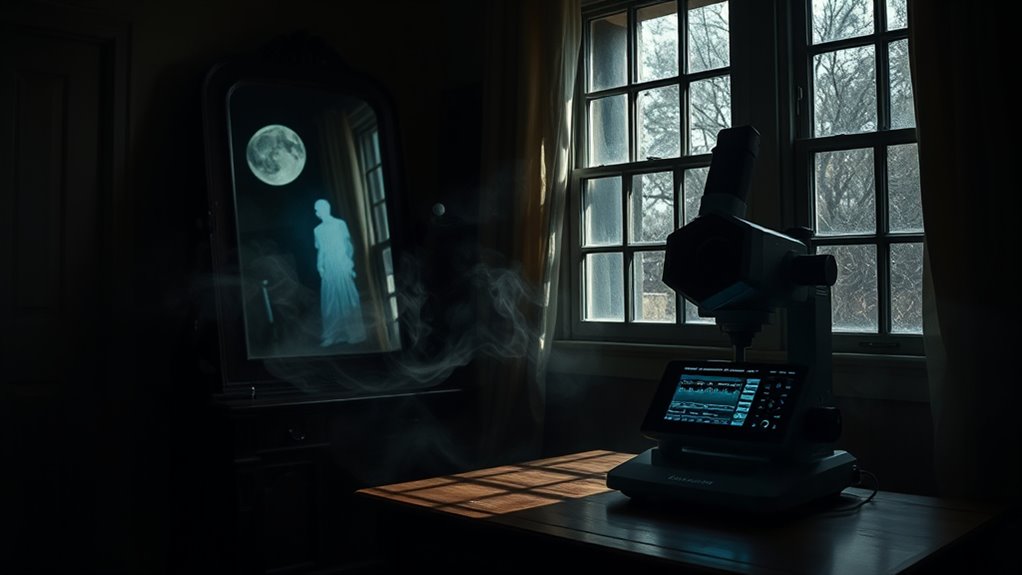
Around 39% of Americans believe in ghosts, reflecting a significant interest in the supernatural. This belief can vary widely; for instance, a 2018 survey showed that about 58% of U.S. respondents thought certain places were haunted. Ghosts rank among the most popular paranormal phenomena, alongside aliens and ESP. Curiously, belief in ghosts often differs by gender, with women more likely to believe than men. Additionally, a recent study in the Netherlands found that 55.6% of respondents identified as paranormal believers, indicating a broader trend in belief across different populations. Studies suggest that strong communication skills can enhance relationships, as those who foster open dialogue may be more likely to share their beliefs and experiences. Furthermore, cultivating unconditional love can create a safe environment for discussing and exploring differing viewpoints. Education also plays a role—higher education levels tend to correlate with lower belief in the supernatural. Interestingly, effective co-parenting plans may also reflect how beliefs are discussed and negotiated within families, highlighting a diverse landscape of perspectives influenced by various factors, including racial and ethnic backgrounds. Furthermore, trust issues with boyfriend no-shows can complicate discussions about beliefs, as underlying relationship dynamics often affect communication and openness.
Scientific Explanations for Ghost Sightings

While many people report ghost sightings, scientific explanations often reveal more about human perception than about the supernatural.
Hallucinations, particularly during sleep paralysis or due to psychological disorders, can easily be misinterpreted as ghostly encounters. Your brain might also create patterns in random stimuli, leading to experiences that seem paranormal. Changes in your brain activity, especially in the temporal lobe, can occur in unusual magnetic fields, simulating supernatural sensations. Environmental factors like infrasound and carbon monoxide poisoning can induce feelings of dread or hallucinations, with infrasound below 20 hertz causing anxiety and distress in some individuals. Additionally, advances in AI technology have contributed to understanding how environmental variables can influence human behavior and perception. Furthermore, the power of suggestion often plays a crucial role in shaping our beliefs about the unknown, leading to a tendency to attribute unexplained experiences to ghosts. Interestingly, many cultures have developed their own supernatural narratives that reflect common themes in ghost stories, which can further influence personal interpretations of experiences. In addition, factors such as battery capacity in solar energy systems can impact the reliability of power sources, paralleling how external conditions can affect our perceptions and experiences. Research into cybersecurity vulnerabilities during major outages also highlights how environmental conditions can affect our emotional state and perception, making us more susceptible to interpreting ambiguous stimuli as ghostly phenomena. Finally, the power of suggestion and cultural narratives can shape your interpretations, making you more likely to perceive ghostly phenomena in ambiguous situations.
Ultimately, science often debunks these sightings as natural misinterpretations.
Psychological Factors Influencing Perception
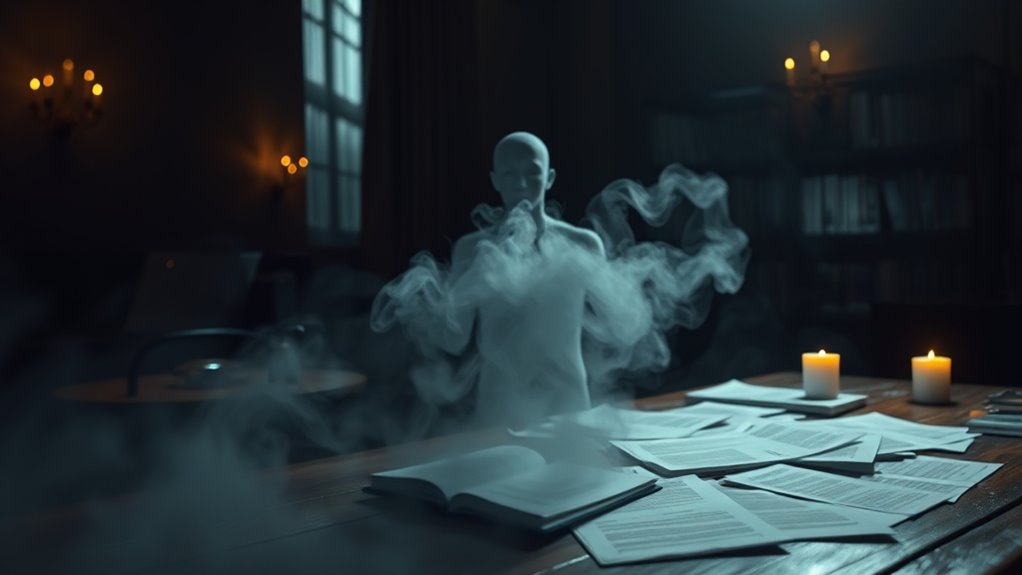
Perception is often shaped by a complex interplay of psychological factors that influence how we interpret our experiences. Cognitive biases can lead you to misattribute ordinary events as ghostly encounters, especially in dimly lit, eerie environments. Your prior beliefs about ghosts greatly color your interpretations, making you more likely to perceive the paranormal. Additionally, emotional states like fear can heighten your sensory sensitivity, amplifying perceptions of ghostly happenings. Cultivating mindfulness practices can help ground your perceptions and reduce the intensity of these experiences. Research suggests that engaging in positive thinking can also help mitigate fear-related sensations, leading to a more balanced perspective. Furthermore, incorporating stress management techniques can enhance your ability to cope with anxiety and uncertainty related to perceived paranormal activities. Cultural backgrounds also play a role, linking community values and fears to ghost perceptions. Moreover, exposure to certain molds may contribute to experiences interpreted as ghostly, further complicating your understanding of paranormal phenomena. In contexts of sensory deprivation, your brain may fill in gaps with imagined figures. The tendency to share awkward moments related to fear and uncertainty can also influence how ghostly experiences are perceived, making them seem more relatable and real. Expecting to see a ghost can further distort your interpretation of ambiguous stimuli, making the supernatural feel more real. Engaging in mindfulness techniques can help reduce anxiety around these experiences, allowing for a more grounded perspective.
Physical Phenomena Behind Ghostly Encounters
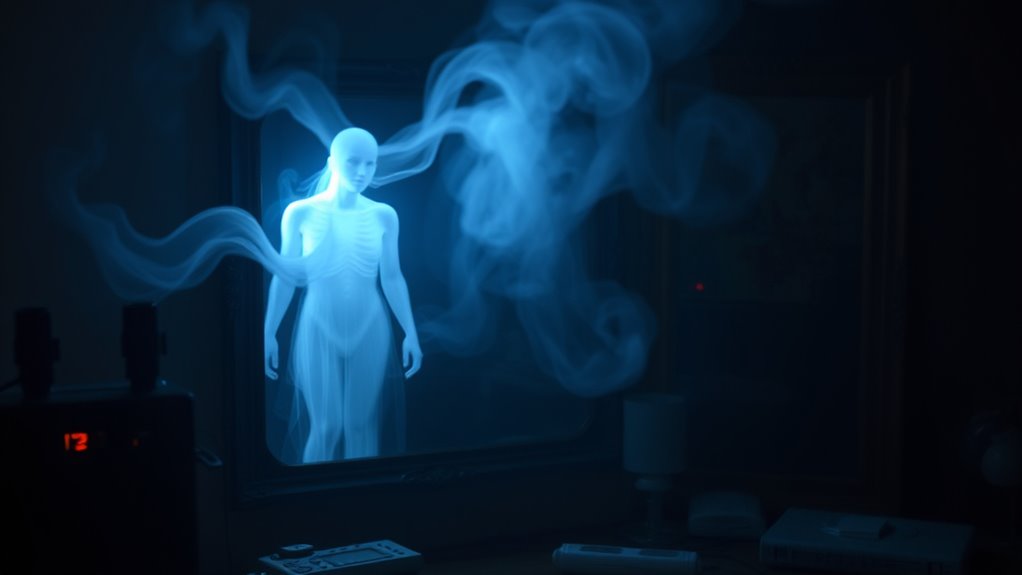
Many experiences that people attribute to ghostly encounters can be traced back to physical phenomena. For instance, unusual lighting or atmospheric conditions can distort your perception, making you believe you see a ghost. Changes in electromagnetic fields or odd acoustic effects can create sensations that feel supernatural. You might hear unexplained noises, like creaks in old buildings, which often stem from natural processes rather than paranormal activity. If ghosts existed, they’d need to follow physical laws, yet they’re described as passing through solid objects, contradicting their supposed interactions with matter. Furthermore, concepts like “energy” in ghost discussions often stray from scientifically recognized forms, raising questions about the validity of these claims. Understanding these physical explanations can demystify ghostly experiences. Additionally, over 50 million spirit encounters are estimated to have occurred in the U.S., highlighting the prevalence of misinterpretations of natural phenomena. The frequent misinterpretation of sounds, such as creaks in old buildings, can often be explained by routine maintenance needs that result in structural shifts. In many cases, these misinterpretations can occur due to the enhanced natural language processing capabilities of AI, which help us understand and analyze human perception of such phenomena. Moreover, the fascination with haunted places often stems from cultural narratives that enhance the allure of the unexplained. This interest can also be linked to the importance of processing loss, as people seek to find meaning in their experiences. Additionally, many people overlook the role of preventative measures that can help mitigate anxiety related to perceived ghostly encounters.
Investigating Claims of Ghost Sightings

As you investigate the world of ghost sightings, it’s essential to approach these claims with a critical mindset.
Start by gathering evidence, like photos or recordings, and conduct witness interviews to check for consistency. Research the location’s history to identify any patterns of paranormal activity and analyze environmental factors that could explain the experiences. Understanding that emotional energy often triggers manifestations can provide context for reported sightings.
Use tools like EMF meters, EVP recorders, and thermographic cameras to collect data. Employ controlled experiments and double-blind studies to minimize bias.
Always consult experts, both believers and skeptics, to gain diverse perspectives. Remember, the lack of consensus and the subjective nature of experiences can complicate verification.
Stay objective and open-minded as you sift through the evidence.
The Role of Social Influence on Ghost Beliefs
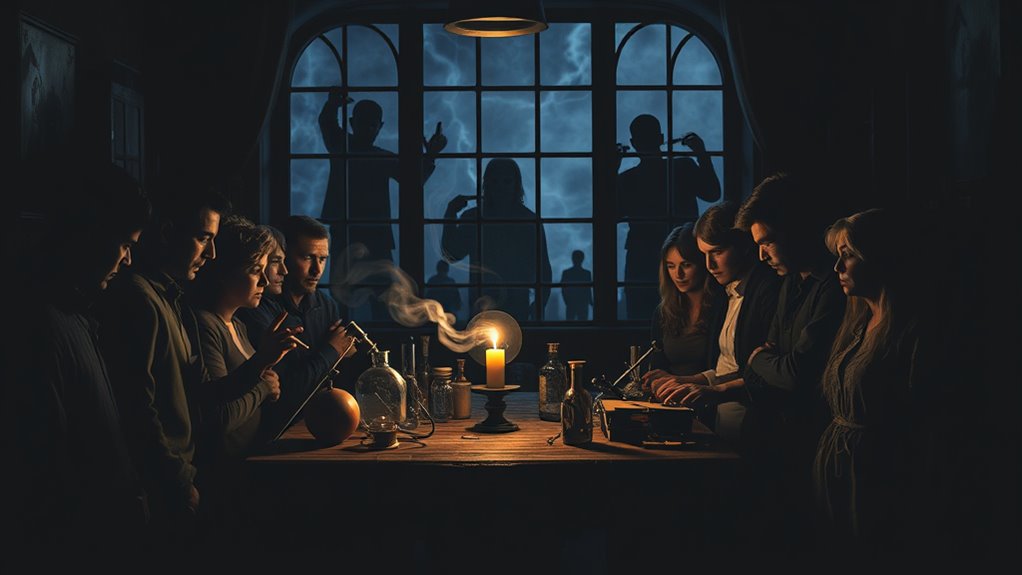
Investigating ghost sightings often reveals how social factors shape beliefs in the paranormal. Your family background and peer group play essential roles in forming these beliefs, often through shared experiences. If your parents or friends discuss ghosts, you’re likely to adopt similar views. Media also amplifies these beliefs; movies and TV shows can spark fascination and reinforce what you think about ghosts. Charismatic leaders or cultural narratives further influence your perspective, often intertwining ghost beliefs with traditional practices. Additionally, cultural norms within your social circles can either support or challenge your beliefs. Ultimately, social influences create a framework that makes ghost beliefs feel more valid, even without empirical evidence to back them up. Psychological and environmental factors often explain ghostly encounters, revealing that ghost phenomena fall outside the current scientific scope.
The Impact of Individual Perception
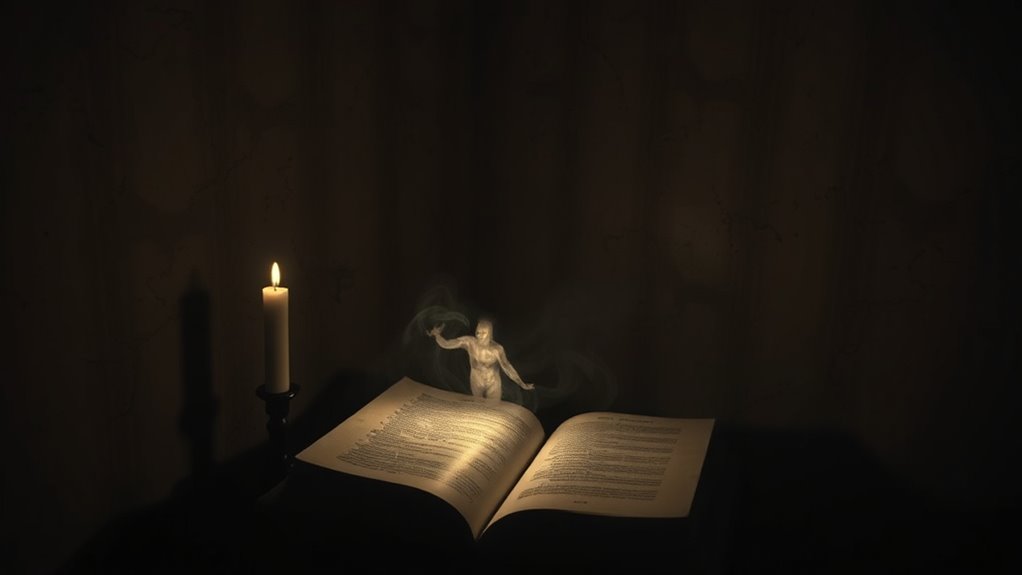
How do your personal experiences shape your perception of ghosts? Your brain is wired to recognize patterns, so when you see a shadow or hear a sound, you might interpret it as paranormal activity. Fear and uncertainty can heighten these perceptions, making you more likely to believe in ghostly encounters. If you already have a belief in ghosts, you’ll interpret ambiguous stimuli in ways that confirm your beliefs. Additionally, individuals inclined to believe in ghosts report more sightings, which underscores how deeply personal beliefs can influence experiences. Environmental factors, like low lighting or unusual sounds, can also influence what you perceive. Additionally, cultural and folkloric influences shape your understanding, making you more susceptible to interpreting experiences as supernatural. Ultimately, your unique combination of psychological, neurological, and environmental factors determines how you perceive the ghostly.
Ongoing Research and Public Fascination
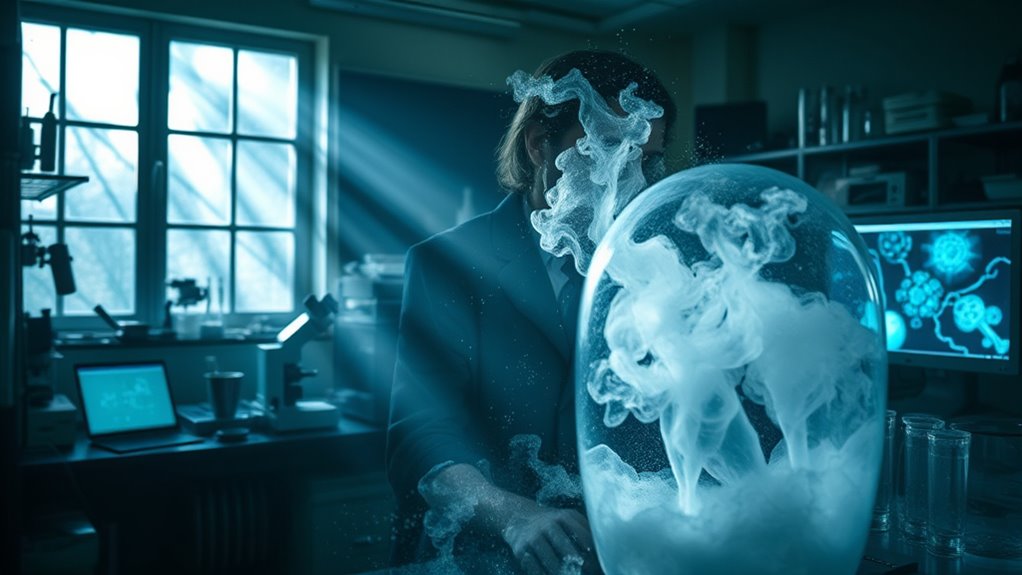
While many people dismiss ghosts as mere folklore, ongoing research into paranormal phenomena continues to captivate the public’s imagination. Events like the Paranormal Research Symposium 2025 in Gettysburg blend academic and spiritual perspectives, inviting you to explore structured presentations and workshops.
Unlike typical conventions, these symposiums emphasize critical analysis and evidence-based investigations of ghostly claims. Meanwhile, the Haunted America Conference lures you in with diverse speakers and engaging activities, including presentations on ghosts and hauntings.
Tours offered by US Ghost Adventures in over 100 cities cater to your curiosity about ghost stories. This blend of research, entertainment, and cultural significance illustrates a growing fascination with the unknown, drawing you deeper into the mystery of ghosts and the scientific efforts to explain them.
Frequently Asked Questions
What Are Common Ghost Hunting Techniques Used Today?
Today, you’ll find various ghost hunting techniques that enthusiasts rely on. EMF meters help you detect electromagnetic anomalies, while digital recorders capture EVPs.
You might use infrared cameras for low-light investigations or spirit boxes to communicate with spirits. Flashlight communication and REM Pods allow for interactive experiences.
Additionally, paying attention to environmental changes can signal paranormal activity, and controlled experiments provide a structured approach to your investigations.
How Do Different Cultures Define Ghosts?
You might be surprised to learn that ghosts aren’t defined the same way everywhere. In some cultures, they’re viewed as benevolent guardians, while others see them as vengeful spirits.
For instance, Japanese yūrei embody unresolved emotions, whereas Chinese hungry ghosts represent unfulfilled desires.
These definitions shape folklore, rituals, and even festivals, reflecting deep-rooted beliefs about life, death, and the connections between the living and the dead.
It’s fascinating how perspectives vary across cultures!
Are There Famous Ghost Sightings With Documented Evidence?
Absolutely, there are several famous ghost sightings with documented evidence.
You might’ve heard of the Brown Lady of Raynham Hall, captured in a 1936 photograph. The Enfield Poltergeist gained attention for its bizarre activity, while the Amityville Ghost was photographed by investigators Ed and Lorraine Warren.
Each case sparks curiosity, as they often include compelling narratives and visuals that challenge your understanding of the paranormal.
What Psychological Disorders Are Linked to Ghost Sightings?
Several psychological disorders link to ghost sightings. If you’re experiencing high anxiety or stress, you might be more prone to perceive paranormal events.
Conditions like sleep paralysis can lead to vivid hallucinations, often interpreted as ghostly encounters.
Individuals with schizotypy may also misinterpret unusual perceptions as supernatural.
Additionally, cognitive disorganization can skew your sensory experiences, making the line between reality and the paranormal blur, influencing your beliefs and interpretations.
How Do Ghost Tours Influence Public Perceptions of Hauntings?
Ghost tours shape your perceptions of hauntings by blending history with intriguing tales, making you more receptive to the supernatural.
As you explore these eerie sites, the emotional engagement heightens your fascination with fear and the unknown.
The stories often reflect local folklore, reinforcing cultural beliefs and myths about the paranormal.
This combination of thrill and history creates memorable experiences, influencing how you view hauntings in relation to the community’s heritage.
Conclusion
To sum up, while science may not provide concrete evidence for ghosts, it offers intriguing insights into our beliefs and perceptions. Did you know that about 45% of Americans believe in some form of ghostly presence? This statistic highlights how widespread these beliefs are, often fueled by psychological factors and cultural influences. As ongoing research continues to explore the phenomenon, it’s clear that our fascination with ghosts reflects deeper aspects of human nature and our quest for understanding the unknown.

